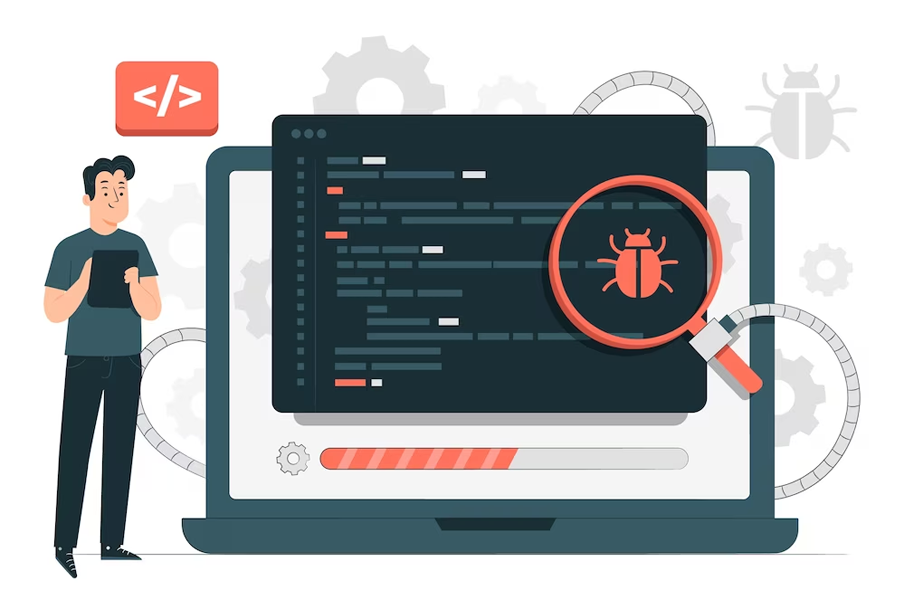Whatever kind of website you have, if your target audience finds something wrong with it, it might as well not exist. That’s why website testing is a critical component of your development process. It ensures that your potential customers get only the best from you.
In this article, we will discuss web testing and how your e-commerce websites can benefit from it.
What is Website Testing: A Brief Overview and Purposes

People don’t have the patience for buggy websites and will immediately leave them. This is bad for your business, as fewer eyeballs on your website means fewer sales. That’s why you need a thorough battery of website tests in every development process.
The web testing and bug tracking process (also called web application testing) thoroughly examines your online platform to guarantee its optimal performance. This involves scrutinizing elements like functionality, usability, and compatibility to ensure a user-friendly and error-free browsing experience.
Investing in website testing efforts isn’t just about error detection. It’s a strategic move that will strengthen the foundation of your business.
Types of Website Testing: Overview and Comparison
Understanding the types of website testing is crucial for tailoring your testing approach to specific characteristics and functionalities of your site.
Website testing types are categorized based on the nature and complexity of the site. The factors that determine this complexity include the content management system, interactivity, and specific functionalities.
Broadly speaking, whenever you test websites, they usually fall under four categories: static websites, dynamic CMS websites, e-commerce platforms, and mobile websites.
Each of these types requires a tailored testing approach to address unique challenges and ensure optimal performance.
Preparing for Website Testing: Defining Goals and Objectives
As a business owner, when gearing up for a critical phase in optimizing your online presence, clear communication between your development team is critical. Knowing how to prepare helps ensure a streamlined, purposeful testing process that actually aligns with your business goals.
Before you start the testing process, make two things your priority: clear objectives and user-centricity:
- Clear objectives: Clearly articulate the goals of the testing phase. Whether it’s enhancing site performance, improving website UI (user interface), or fixing compatibility issues, defining specific objectives provides your development team with a focused roadmap.
- User-centric focus: As a leader, you must emphasize the importance of focusing on the customer. You can go as far as to conduct crowdsourced testing by allowing your community to test all the features on your website before launch (open or controlled exploratory tests).
This way, you can prioritize test scenarios that directly impact your website visitors, ensuring that the website meets technical user experience standards and exceeds user expectations.
The 14 Most Important Website Tests to Conduct
Ensuring your e-commerce website operates at the top form requires a strategic approach.
From functionality to user experience, the 14 crucial tests in the paragraphs below cover a range of elements vital for your thriving online platform.
Usability Testing
You perform usability testing by evaluating your website interface for intuitiveness and user-friendliness (also known as interface testing). E-commerce can be incredibly competitive, whatever niche or industry you operate in.
It’s critical to ensure that your customers can effortlessly navigate your site — or else they’ll just go to your competitors, after all, 71% of all businesses also have a website, according to Forbes.
This involves the following:
- Creating realistic sample testing scenarios;
- Observing user interactions, and;
- Collecting actual feedback.
Also, use testing tools like heatmaps, session recordings, and user surveys to gain comprehensive insights into how users navigate and engage with your site.
Functional Testing
Website functionality testing involves ensuring your website works by testing features like link forms, external links and internal links, databases, and other interactive elements to guarantee a seamless and error-free user experience.
For an e-commerce website, flawless functionality is non-negotiable. Any glitch in the purchasing process, from broken links to malfunctioning checkout forms, results in frustrated customers and lost sales.
Functional testing will detect and fix these issues, protecting you against customer complaints and SEO inefficiencies (caused by a broken link).
For thorough functional testing, you can do the following:
- Streamline business workflow.
- Ensure that your forms are working.
- Check user input and responses (API testing).
- Ensure your database server is functioning optimally (database server interface testing).
- Make sure you’re testing cookies’ pop ups and their functionality.
- Test all the links in your website, making sure they lead to the expected page (outgoing, same web page, different web pages, internal, anchor, mailto).
Last but not least, don’t forget to test HTML and CSS codes for easier site crawling by search engines.
Cross-Browser Compatibility Testing
The browser compatibility test evaluates your website’s performance across different browsers like Chrome, Firefox, Internet Explorer, and Safari. This web tester identifies and solves issues from browser compatibility, preventing potential frustrations and safeguarding your online reputation.
There are many different browser types out there, and not running on one of them effectively blocks you from millions of potential customers. You can use a combination of manual testing and automated web testing tools for this.
Manually check your website on popular browsers by paying attention to design elements, functionality, and responsiveness. Automated testing tools like Lambda Test can streamline the process by simulating user interactions across multiple browsers simultaneously.

Mobile-Friendly Testing
In Malaysia, users of mobile devices are increasing by the millions – they’re projected to be over 30 million by 2025. The mobile experience will play a massive role in years to come. Not testing for mobile optimization (and operating system optimization) is one of the biggest mistakes you could make as a business owner.
To conduct effective mobile website testing, use a range of different devices and emulators to conduct responsive testing for various devices, simulate diverse user experiences, and test different operating systems by conducting cross-platform testing.
Web Performance Testing
We don’t often think about it, but loading times and website speeds carry massive impacts. Ideally, e-commerce websites should aim for a loading speed under three seconds. Users expect instant access to information and swift transaction processes, so you keep an eye on your loading times by conducting performance tests.
You can utilize tools to measure page load times, identify bottlenecks, and conduct a load test (stress testing) to assess how the site handles normal and peak loads of traffic.
stress testing. You can also implement CDNs (content delivery networks), optimize images, and utilize browser caching to enhance performance and the load on the web server.
Accessibility Testing
Site accessibility ensures your website is designed and developed to accommodate users of all abilities, including those with disabilities. Over 27% of adults in the US live with some kind of disability. In Malaysia, that number registers at about 12% of adults. While those percentages might seem low, they number in the millions.
It’s not just a moral argument to keep your websites accessible, it’s also a sound strategic investment: inclusive commerce websites can sell to more people.
Security Testing
Testing your website’s security identifies vulnerabilities that could be exploited by malicious actors. This examines how safely your site can store sensitive customer information, financial transactions, and other confidential or restricted files.
The consequences of security breaches are immense, so data integrity among your websites and various web applications is a must. Effective network and information security testing involves various techniques like penetration testing, vulnerability scanning, and code review.
Engage with professional security experts for their professional advice. Also, stay informed about the latest cybersecurity threats and mitigation strategies to ensure your website remains resilient against evolving security challenges.
Content Testing
Your content is what will make people stay on your website. No matter how great your design is or how quickly your web pages load, if your content is irrelevant or unreadable, your customers will press that X button quickly.
Content testing looks for content errors in your e-commerce website. Aspects like accuracy, relevance, and readability are checked. Through this, your business can maintain a professional and reliable online presence.
Implement effective content testing with checking systems like proofreading, editing processes, and feedback gathering.
Validating Form Functionality and Data Handling
This testing examines specific functionalities like registration forms, checkout processes, and any interactive elements collecting user data. Forms and transactions are critical touchpoints in the customer journey, so any glitches or vulnerabilities in these processes often lead to user frustration, abandonment of shopping carts, and even potential security risks.
Effective testing involves simulating real-world scenarios to identify potential issues.
Verifying Compatibility with Third-Party Integrations
You just can’t see it, but your business website is integrated with a dozen third-party programs at any given time. Payment gateways, shipping services, and even CRM systems – all these are critical components of your e-commerce site.
Because of the complexity of e-commerce website development, these integrations are often swept under the rug. Until you see an error message. Compatibility testing prevents nasty surprises. It identifies and addresses any issues arising when integrating with these many external services.
Effective compatibility testing involves testing each third-party integration individually and combined with others. This doesn’t just happen one day. It must be baked into the development process, to ensure your components are regularly tested.
Multilingual and Localization Testing
Localization testing is one of the website testing methods dealing with content. It ensures that your content, design, and functionalities cater to the linguistic and cultural nuances of the geographic location that you’re trying to target.
For example, if you’re a brand seeking to expand in the Malaysian market, your campaign will die a slow death if you don’t recreate the same website, optimized for a Malaysian audience. If you’re a global brand, then multilingual and localization processes are all the more critical.
This testing involves verifying the accuracy of translations, assessing cultural appropriateness, and confirming the website functionality in each targeted locale.
Involving End Users in the Testing Process
User Acceptance Testing (UAT) is the final phase of the testing process where your end users actively participate in evaluating your website. UAT is crucial for e-commerce sites because it provides a real-world validation of the website’s usability and functionality. End users can identify issues that are overlooked during earlier testing phases.
Effective user acceptance testing involves utilizing a diverse group of end users representing the actual target audience. Ensure you provide clear guidelines and instructions, implement realistic scenarios, and encourage users to use the website realistically.
Finally, ensure you provide robust collaboration tools and feedback mechanisms to ensure streamlined communication between your testers and the development team.
Streamlining and Automating Testing Processes
Due to the complexity and scale of testing required, many website owners use automated tests. Test automation uses specialized test automation tools, test scripts, and even AI to automate the execution of test cases and the comparison of actual outcomes with expected outcomes.
With many different network speeds, functionalities, browsers, and devices to consider, manual testing can be time-consuming and even prone to human error. Automation solves this issue, delivering high-quality software and websites efficiently.
This is especially valuable for critical e-commerce functionalities like your main login page, checkout processes, form submissions, and transaction handling. Some of the most widely used web app software testing tools available are LambdaTest, Test Sigma, and Selenium.
Ongoing Monitoring and Continuous Improvement
Website testing isn’t a one-off thing, it’s a continuous process. Continuous testing post-launch is an essential process for ensuring the sustained success of your business site. This is because new issues pop out all the time, given how quickly everything moves on the internet.
Here are some of the best practices for beta testing your website:
- Utilize real-time analytics: Leverage analytics tools to track user behavior, site traffic, and website performance metrics in real time.
- Gather user feedback: Establish channels for user feedback, encouraging customers to report issues and provide suggestions for improvement.
- Schedule a battery of core tests: Conduct performance testing, security audits, cross-browser testing, and accessibility checks regularly.
- Regularly update content: Review and update website content to reflect crucial product, service, and promotion changes.
These best practices in ongoing monitoring and continuous improvement maintain the health of your online storefront. They also demonstrate your commitment to delivering an exceptional and consistent user experience.

Final Thoughts
Nobody wants a shopping website that crashes during peak season, displays unoptimized content on mobile, and loads very slowly.
Whether you have a highly dynamic e-shop or a static website for your small business, continuous website testing is a must if you want a long-lived, robust, and high-performing website.
The testing of a website might sound complicated and daunting, but proper information will address most of those issues. With this guide, you can go talk to your development team, IT guy, or whatever you have and initiate a round of website improvements.
Frequently Asked Questions
Are these the only types of web testing available?
No, there are many other forms of website applications that all have their dedicated tests. For example, you can conduct dynamic web application testing, change-related testing, simple static website testing, database testing, regression testing, cookie testing, and more. They require coding skills — speak to your developer team to know more.
Which aspect of my e-commerce site should I check first?
Prioritize testing based on critical user journeys and functionalities. Start with foundational elements like usability, functionality, and security. As your site evolves, expand testing to cover performance, compatibility, and other aspects relevant to your business goals.
How often should I conduct website testing?
Regular testing is crucial, especially during significant updates or changes. Aim for a balance between routine checks and more extensive testing phases to adapt to evolving user expectations, technological advancements, and industry standards.